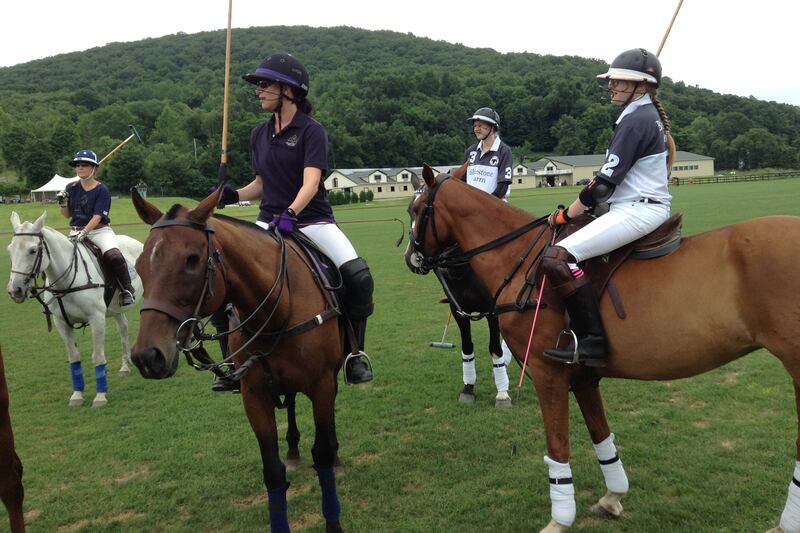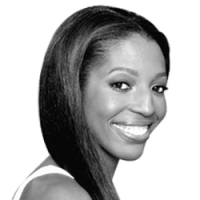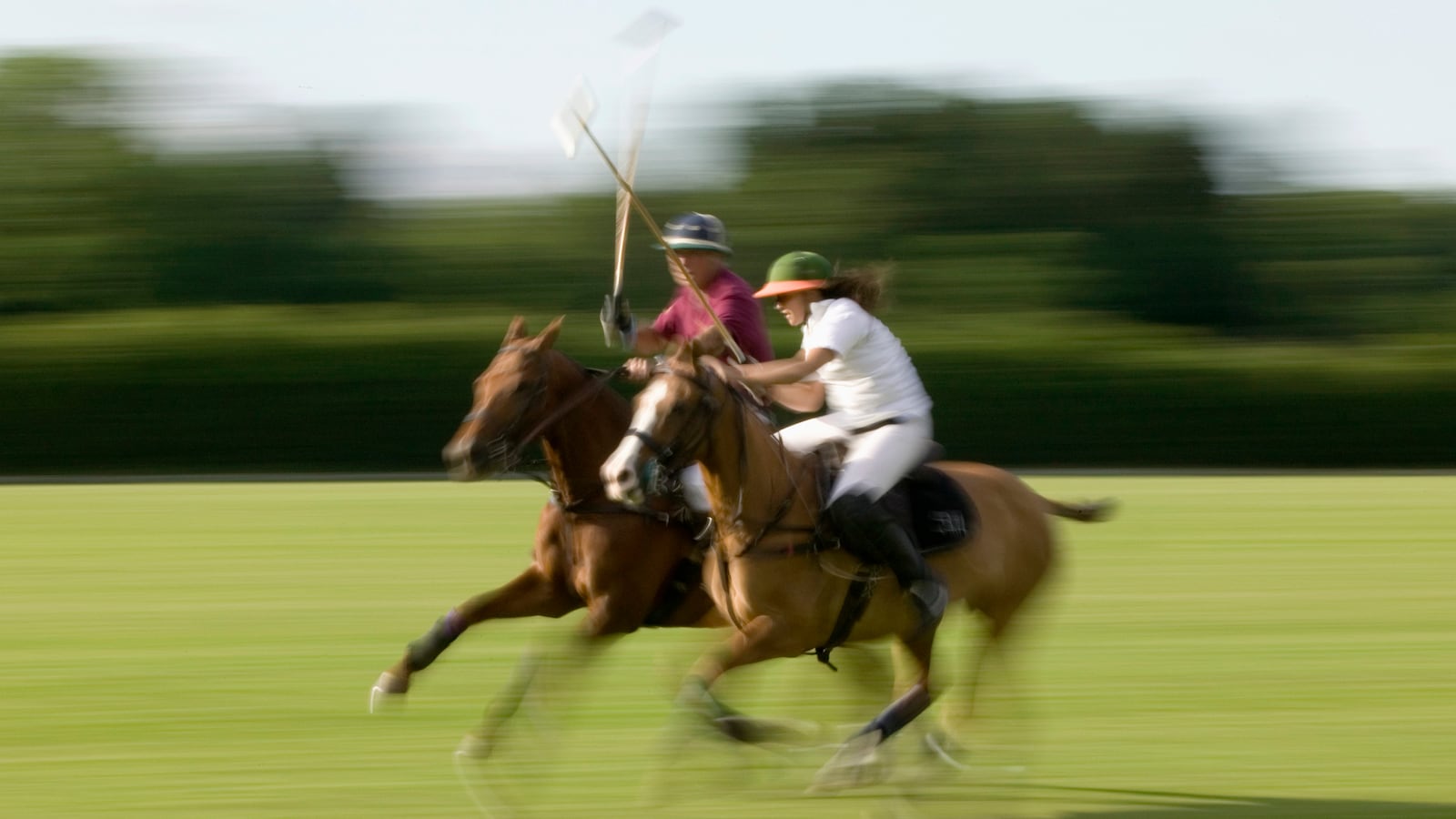When the average person thinks of women in the world of polo, they are likely to envision celebrities and socialites clad in designer sundresses and chic hats observing the action; of Kate Middleton cheering her husband Prince William on.
They are less likely to picture Karrie Goldberg, who can be found sporting leather pants, not sundresses, when off the polo field, and giving male players a serious run for their money on it.
“She’s on fire today,” an observer could be heard saying at Haviland Hollow Farm in upstate New York, as Goldberg confidently raced across the field on one of the farm’s polo ponies during a weekend practice session with other amateur women players.
Goldberg is neither a celebrity nor socialite, though she works with many in her role as founder of the Kagency, a leading Manhattan-based marketing and events firm.

Watching Goldberg gracefully maneuver around the field, it’s easy to forget she is playing what has long been considered one of the world’s most dangerous and masculine sports. In February, Carlos Gracida, best known for being the favored polo instructor of England’s royal family, died of injuries suffered in a polo match at the Everglades Polo Club in Florida.
But Goldberg shows no fear on the polo field. She is part of a growing number of women embracing polo as a leisure sport. Female membership of the U.S. Polo Association was up 68 percent in 2013 compared with five years earlier. By contrast, male membership only increased 15 percent in the same period.
Many of the women taking up polo are like Goldberg: glamorous, successful and seeking something other than the usual Pilates and tennis offerings their equally successful and glamorous friends enjoy. Some of the other women Goldberg frequently plays with at Haviland Hollow Farm include Anne Vincent, who served as director of events at Vogue before recently moving to Burberry, and Laurel Boylen of the FuTek think tank.
The boom in women’s polo is surprising. The sport was notoriously unwelcoming to women players, both professional and amateur, for much of its nearly 2,000-year existence. For two decades Sue Sally (“Sal”) Hale disguised herself as a man so that she could play in matches with men around the country. Her achievements finally led the United States Polo Association to begin admitting women in 1972.
Since that time professional women players have thrived, one being Sue’s daughter, Sunny Hale. In 2000 she became the first woman to play on a team that won the United States Open. Her teammates were men.
In an email to The Daily Beast, Sunny Hale noted that helping to increase the number of women playing polo is one of her proudest accomplishments, next to the numerous tournaments she has won. “To grow the opportunity for more women and young girls to connect through this great sport and the passion they share in it is complete satisfaction,” she wrote. “That was not available when I started in the sport and now young girls around the world can start at a young age making friends and competing in something they love.”
The fact that Sunny can excel at a sport in which she regularly faces male opponents is one of the key details that distinguishes polo from other sports, and makes it attractive to women.
Unlike football or even basketball, in which it is not common to see men and women playing on amateur or professional teams together, in polo horses render gender differences essentially moot. If everyone is playing on a fast and strong horse, at that point it essentially becomes about who demonstrates the most strategy and skill in hitting the ball.
A basketball player in her teen years, Goldberg became a veteran of various exercise fads in adulthood. Multiple knee injuries left her looking for something that would allow her to have fun, stay in shape and not endanger her vulnerable knee. Four years ago she was introduced to polo.
“It’s an amazing workout and it’s great stress relief,” Goldberg said of what has fueled her self-described “addiction” to polo. As someone whose career requires that she often appear at some of Manhattan’s glitziest events and constantly be “on,” there is nothing like hopping on a horse to help her decompress. Polo is one of the few physical activities that exercises virtually every part of the body. You need incredibly strong legs to steady yourself on the horse. Strong arms to hit the ball and a strong core for positioning. (After ONE practice session on a wooden horse my arm and legs were sore days later.)
Another reason polo is booming among women is that there are more professionally and financially successful women than ever before. Polo is not a cheap sport. At Haviland Hollow Farm, for instance, a 10-lesson package costs $1,500, which is considered an extremely economical deal on the polo circuit.
With more women achieving financial parity with men, more women are able to take up luxury hobbies men have long enjoyed. But those interviewed for this piece took pains to stress that the stereotype that has long persisted about who plays polo is skewed.
“I think polo gets a little bit of a bad rep for the type of people that play,” Goldberg said. “It really isn’t the stereotype people think of—the banker with the private plane.”
Sunny Hale agrees. “The only side of polo that is usually publicized or written about is the huge and unique ability of the sport to attract royalty, movie stars and extremely wealthy people all in one place at a beautiful setting at the top level of our sport,” she wrote in an email. “That level of the sport is called ‘High Goal’ and would be comparable to [what] Nascar [is to] auto racing, the NBA in basketball, the World Series in baseball.”
She went on to explain that just as there are people who go to parks to play a pickup game of basketball or baseball, which is cheaper than playing in the pro leagues, people can find cost-effective ways to play polo.
More women are, aided by efforts of those like Sam Ramirez Jr., the owner of Haviland Hollow Farm Polo Club, who has strived to find ways to attract more non-traditional players. In addition to offering lesson packages with more appealing rates than some clubs, he also provides the option of leasing horses at varying time frames and rates for those for whom owning a horse is not a financial possibility.
He expressed pride at the talent and commitment of the amateur female players who have joined his club. When asked to elaborate about other strategies he is exploring to attract more female players, he joked: “Good-looking guys.”
America is not the only country in which polo is gaining popularity with women. In 2003 Nina Clarkin, a British player, became the first woman to play on a team that won the Veuve Cliquot Gold Cup. Uneku Atawodi, currently the only black professional player in the world, is credited with increasing interest in Africa. Polo once thrived Nigeria, and Atawodi is considered a symbol of its resurgence among the monied classes there, though she herself is middle class.
Karen Berger, another regular player at Haviland Hollow Farm said the appeal of polo for her is multifaceted. “Skiing, you’re by yourself. Golf, you’re by yourself. If you’re running you’re by yourself. At least with polo you’re working as a group.”
She paused then added, “I don’t necessarily think women are great with women. Women aren’t always super-supportive of one another. You’re really good through high school and college and then you start to get really competitive with one another and I think as professionals it’s just super to be able to play as a unit and support one another.”
Goldberg explained that for those who are super driven and accomplished, one is always seeking a more thrilling and fulfilling endeavor. Polo can fill that void, and adds a multitude of color to one’s life. “You get a lot of interesting reactions walking around Chelsea with a riding crop,” she said. “Today one guy stopped me and said, ‘Honey, where were you last night?’ I told him it was for horses and he quipped, ‘That’s what they all say.’”






